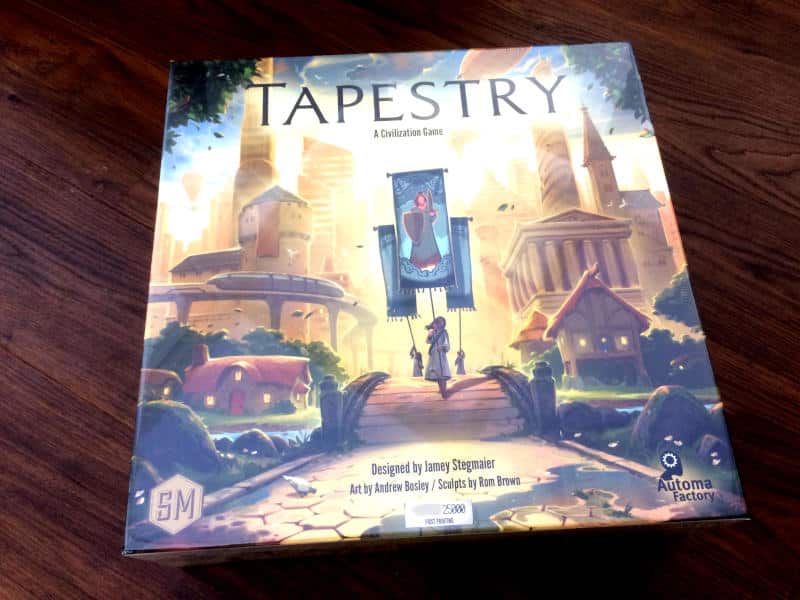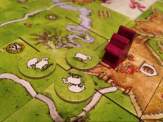Now don’t get me wrong. I don’t mind long games. I happily play the same game for two to three hours, as long as it keeps me captivated. Even when a game requires a lot of focus and concentration, I usually have no problem sticking with it for a few hours. One of the ways in which a game can keep players invested is by reducing the amount of downtime, that is the time it takes for a turn to come back round to you. Something that helps in this respect is overlapping turns, which I want to look at more closely in this article.
Listen to the Audio Version
Intro Music: Bomber (Sting) by Riot (https://www.
Music: https://www.purple-planet.com
Non-Overlapping Turns
Generally speaking, if you want a game to go a bit quicker, you should start thinking about your next turn after your current turn is over, if not even during your current turn. It’s usually a good idea to have a rough strategy and plan ahead as far as you can. That way, when the game comes back round to you, you already know what you want to do. You don’t spend any time working out your actions on your turn. When everyone does this, a game can really fly.
It’s not really overlapping turns that I describe here. You don’t actually take your turn. You don’t carry out any actions. However, you do spend time on another player’s go so that you can get on with your turn when it’s yours next. When a game allows you to plan out your turn as a whole or at least to a large part, while others are taking theirs, it’s certainly very welcome. It is still a way of speeding up a game, even when it’s not through overlapping turns in a strict sense.
It can be really frustrating when you basically can’t make any decisions in advance. You might have an overall plan, but if you can’t be sure the actions you so desperately need to follow your strategy will be available on your next go and there aren’t even comparable, if less effective, alternative actions available, there is nothing you can do. You’re left waiting for everyone else to do what they need to do until it’s your turn again. A game like this is tactical rather than strategic. If turns also take a long time, the game will feel slow and frustrating.
Overlapping Turns
So, anything that can be done to speed up rounds, is going to be welcome. Some games have turns that have a clean-up or some sort of housekeeping step at the end. Often, that’s when overlapping turns are possible. If the decisions and actions taken at the end of one player’s turn don’t affect the game state or at least don’t affect what decisions other players will make, then overlapping turns are an option.

Get yourself a wooden Tabletop Games Blog dice tray.
Each tray is the perfect size to roll your dice, and with the soft mat, it’s really quiet, while the wooden frame makes it wonderfully sturdy.
I think Tapestry and Scythe by Stonemaier Games both do this really well and even mention it in their rulebooks. In Tapestry, for example, the next player can usually take their turn as the previous player decides where to place their income building or finishes off their income turn. In Scythe, one player’s bottom-row action usually doesn’t affect the next player. So they can go while the previous player carries out that.
By overlapping turns, both games really speed up a lot. I reckon we have been able to reduce our playtime for 3-player games of Tapestry from almost two hours to around an hour and a half. Our first few 3-player games of Scythe lasted about two hours and now they regularly are done in an hour and a bit. That’s a huge speed boost for games that are already relatively short.
I try to find ways of overlapping turns in every game I play that’s familiar to everyone and that would normally take around two or more hours to play.

Simultaneous Turns
Some games take it to another level. Instead of overlapping turns, everyone plays at the same time. Simultaneous turns are the other extreme of speeding up games. If you have played Karuba, you will know what I’m talking about. In this tile-laying game, one player randomly draws a tile and then everyone else around the table finds the same tile in their pile. Then everyone places it on their board and carries out the various actions and effects. So everyone plays at the same time. Everyone only takes their next turn, when everyone has finished their previous one. It really helps the game fly.
Yet, you can take that one step further. You can do away with the concept of turns altogether. Instead, you just have rounds. I would say that Quacks of Quedlinburg is one of the more famous examples of this approach. Here, everyone draws tokens from their bag all at the same time. In fact, some players may be quicker and have drawn and placed more ingredients into their cauldron than everyone else. Everyone just keeps taking turns when they’re ready and until they have to finish for that round. That’s except maybe for the very last round, when the rulebook suggests people draw and place at the same time.
Either way, both games go really very quickly and there is usually very little downtime, because everyone plays at the same time. Even when someone is quicker, turns are usually quite fast. So nobody has to wait for very long until the next turn, or round, as in the case of Quacks.
Multiplayer Solitaire
One thing to bear in mind though is how overlapping turns affect the amount of player interaction. By definition, if one player’s turn affects what another player can do on theirs, then you can’t have overlapping turns, let alone simultaneous turns. So the more turns overlap, the more multiplayer solitaire a game is. That’s unavoidable in my view.
Taking Quacks as the extreme example, the only thing you keep an eye on with regard to other players is their score. The further someone is in the lead, the more risk they might take when drawing ingredients. Someone who is further behind may be a bit more careful to ensure they can score points as well as be able to improve their bag. There is nothing you can do in Quacks to stop someone else or slow them down. There is nothing that they can do that you have to worry about either. It’s a true multi-player solitaire game and of course, that’s not a bad thing. It’s just something to bear in mind.
What About You?
Now I wonder if you can think of anything that can speed up gameplay, other than overlapping turns. Do you have come across anything that you really liked? Can you think of any games that have implemented overlapping turns really well? Are there games that could do with overlapping turns to speed them up and reduce downtime? As always, please share your thoughts in the comments below. I’d love to hear from you.
If you enjoyed this article, please have a look at my support page to see how you can help keep the blog going.
Useful Links
- Tapestry review: https://tabletopgamesblog.
com/ 2019/ 11/ 09/ tapestry-saturday-review/ - Scythe review: https://tabletopgamesblog.
com/ 2019/ 01/ 19/ scythe/ - Karuba review: https://tabletopgamesblog.
com/ 2023/ 04/ 08/ karuba-saturday-review/ - Quacks of Quedlinburg review: https://tabletopgamesblog.
com/ 2020/ 06/ 06/ the-quacks-of-quedlinburg-saturday-review/
7 Comments
What are you thoughts?
Add your thoughts on the topic to the form below and join the conversation.
Audio Version
Intro Music: Bomber (Sting) by Riot (https://www.
Music: https://www.purple-planet.com
Playlist
These are the songs I listened to while I was writing this topic discussion article:






I’ve seen a lot of lifestyle card games in the last ten years shorten individual turns down to one or two actions, instead of the long multi-phase turns with which players of Pokemon and Magic are familiar. Ashes and Star Wars: Destiny both gave players their resources at the beginning of the round, then let them take turns doing only one or two small actions. According to their player bases, games were faster-paced, more interactive, and more tense than games with traditional turn structures.
Hello Evan. Thank you so much for your comment. Reducing the number of actions per turn is definitely a great way of reducing game length. I love your examples as well.
Good overview of a design strategy I don’t feel like I see enough of yet!
One quick note about Quacks: there are some chips that make you care about watching other player’s turns, but they’re employed very cleverly so as not to slow the game down. The black chips in particular have effects based on whether or not the player using them has placed more in their cauldron this turn than that player’s left and right neighbors have. As a result, players who invest in those (costly) black chips need to keep an eye on how many black chips their neighbors are buying and cooking up.
The clever part is that the effect is totalistic — that is, it only takes into consideration the total number of black chips in anyone’s cauldron, regardless of when those chips came out, what they followed, what they preceded, etc. Since it only cares about totals, its effect can’t be resolved until the entire round is over so there’s no way for the black chip’s mechanism to undermine the parallel turn structure. The only decision a player makes about neighboring black chips is whether or not to buy additional ones in the next round.
I’m guessing there are other examples out there as well, but this one deserves mentioning because it’s an edge case where parallel play is fully possible, yet players’ turns can have meaningful interactions with each other.
Hello Drew. I’m glad you liked the article. I love your comment about Quacks and how the ingredients are designed to allow for parallel play. That’s definitely a great design choice that I hadn’t really considered specifically.
Listened to this topic while walking this morning and one thing we’ve learned in game design is that if you need a player to draw cards, make it so they draw at the end of their turn, so they can look at them while others take their turns. A lot of casual games, unfortunately, have you draw at the beginning of your turn, which makes it take longer as you process the new information.
Otherwise, I agree with everything you said about ways to speed up games and the consequences (more multiplayer solitaire).
While I appreciate what simultaneous play does, it sadly doesn’t work for me and Will. I have to often interact with the game for him, since his vision is so deteriorated. So most games takes us a lot longer to play because once my turn is done, I have to help him every step of his turn. Then it gets back to my turn and I can finally think on what I want to do. But the same goes for him, he has to wait for me to read him his cards or tell him other info, to make decisions.
Which is why some things, like why dual-layered boards and uniquely shaped pieces can make such a big difference for us. They enable him to get information on his own.
A good example of a dual-layered board in a game with simultaneous play is Fantastic Factories. He can feel the pips on the dice and place them in the right spots on his board. And we got 3D printed resources, so he can feel the differences. So the only thing he needs my help with is reading his cards and he’s pretty good at remembering things after I read them to him. So we can actually do a mostly simultaneous round of the game and actually play the game close to the time frame expected.
I know this is a bit of a tangent, but multiplayer solitaire games are often better for us because of the lack of player interaction. Any part that is supposed to be kept secret often doesn’t matter, so I’m able to read it all to him. A game that is attacky means I can’t & therefore we can’t play it at all.
And to be clear, I’m not complaining about it, just sharing a different perspective on the consequences of something. I don’t think that every game needs to be for every gamer, it’s impossible.
Hello Sarah. Thank you so much for your comments. It’s great to hear how people with vision impairment deal with this topic of speeding up games. It sounds that it’s all about making the game as easily accessible for Will as possible so that he can play as independently as possible.
Yes, that’s exactly it. 🙂